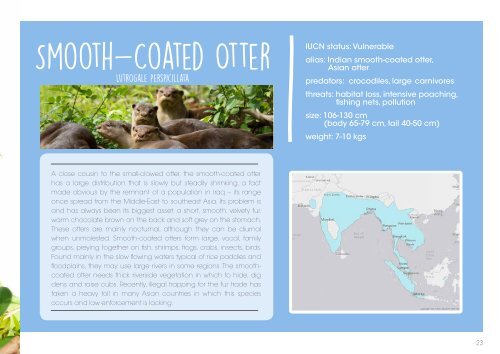OTTERS!
joopj4x
joopj4x
Create successful ePaper yourself
Turn your PDF publications into a flip-book with our unique Google optimized e-Paper software.
Smooth-Coated Otter<br />
Lutrogale perspicillata<br />
IUCN status: Vulnerable<br />
alias: Indian smooth-coated otter,<br />
Asian otter<br />
predators: crocodiles, large carnivores<br />
threats: habitat loss, intensive poaching,<br />
fishing nets, pollution<br />
size: 106-130 cm<br />
(body 65-79 cm, tail 40-50 cm)<br />
weight: 7-10 kgs<br />
A close cousin to the small-clawed otter, the smooth-coated otter<br />
has a large distribution that is slowly but steadily shrinking, a fact<br />
made obvious by the remnant of a population in Iraq – its range<br />
once spread from the Middle-East to southeast Asia. Its problem is<br />
and has always been its biggest asset: a short, smooth, velvety fur,<br />
warm chocolate brown on the back and soft grey on the stomach.<br />
These otters are mainly nocturnal, although they can be diurnal<br />
when unmolested. Smooth-coated otters form large, vocal, family<br />
groups, preying together on fish, shrimps, frogs, crabs, insects, birds.<br />
Found mainly in the slow flowing waters typical of rice paddies and<br />
floodplains, they may use large rivers in some regions. The smoothcoated<br />
otter needs thick riverside vegetation in which to hide, dig<br />
dens and raise cubs. Recently, illegal trapping for the fur trade has<br />
taken a heavy toll in many Asian countries in which this species<br />
occurs and law enforcement is lacking.<br />
23


